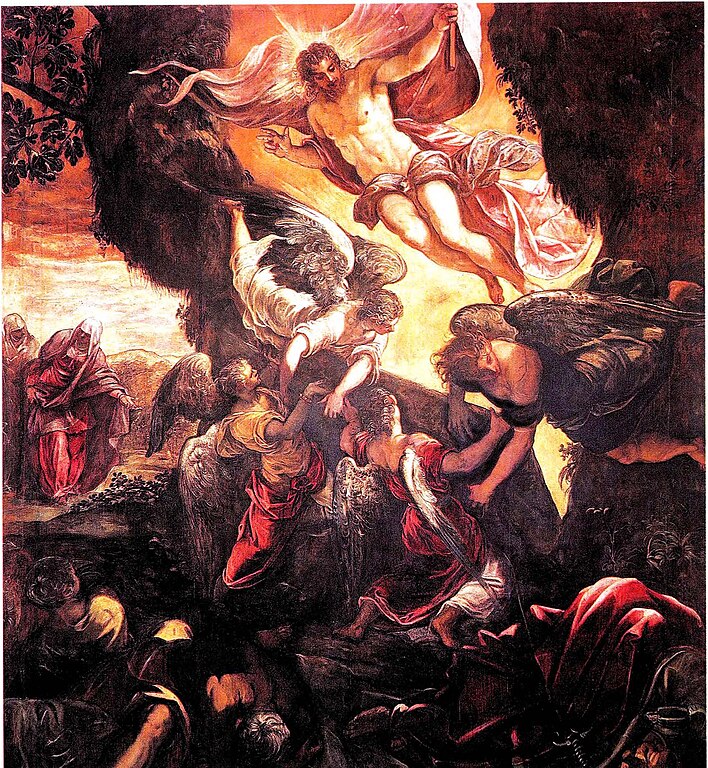The earth was dark twice. Once at the original creation before God first created light. But later there was an even deeper darkness, on Good Friday, between the sixth and ninth hour, when we were crucifying God, and as Jesus dying on the cross cried out, “My God, my God, why have you forsaken me!” Utter darkness. In response to that, God created the most staggering light of all — the resurrection.
It is interesting to look at how Scripture describes the creation of original light. The Bible opens with these words: “In the beginning God created heaven and earth. Now the earth was a formless void and God breathed over the waters. God said, ‘Let there be light’ and there was light.”
A combination of God’s breath and God’s word produced the first light. The ancients identified God’s presence very much with light. For them, God was the antithesis of all darkness and, indeed, the symbol of God’s fidelity was the rainbow, namely, refracted light, light broken open to reveal its spectacular inner beauty.
But it got dark a second time! The Gospels tell us that as Jesus hung on the cross, though it was midday, darkness beset the whole land for three hours. We don’t know exactly what occurred here historically. Was the entire earth plunged into darkness? Perhaps. After all, the earth was crucifying God, and God is light! Irrespective of how literally or not we take this, what happened on Good Friday triggered a different kind of darkness, a moral one — the darkness of godlessness, hatred, paranoia, fear, misguided religion, cruelty, idolatry, ideology, and violence. This is the most blinding darkness of all.
What was God’s response? God’s response to the darkness of Good Friday was to say a second time, “Let there be light!” The resurrection of Jesus is that new light, one which at the end of the day eclipses all other lights.
It is interesting to compare how Scripture describes God creating the new light of the resurrection with how God created the original light at the origins of creation. The Gospel of John has a wonderfully revealing passage that describes Jesus’ first appearance to the whole community after his resurrection.
It tells us that on the evening of Easter Sunday the disciples (representing here the Church) were gathered in a room with the doors locked because of fear. Jesus comes to them, passing right through their locked doors, and stands in the middle of their huddled fearful circle and says to them, “Peace be with you!” And after saying this, he breathes on them and says, “Receive the Holy Spirit.”
Note the parallels to the original creation story. For the writer of John’s Gospel, this huddling in fear behind locked doors is the darkness of Good Friday, a moral “formless void.” And Jesus brings light to that darkness in the same way light was brought to the original creation, through God’s word and God’s breath.
Jesus’ words, “Peace be with you!” are the resurrected Jesus’ way of saying, “Let there be light!” Then, just as at the original creation, God’s breath begins to order the physical chaos, Jesus’ breath, the Holy Spirit, begins to order the moral chaos, continually turning darkness into light — hatred into love, bitterness into graciousness, fear into trust, false religion into true worship, ideology into truth, and vengeance into forgiveness.
The staggering new light that Jesus brings into our world in the resurrection is also one of the things that our Christian creed refers to in its stunning phrase that, in the darkness of Good Friday, Jesus “descended into hell.” What’s meant by this? Into what hell did he descend?
Simply put, the new light of the Resurrection (unlike natural light that can be blocked out) can go through every locked door, every blocked entrance, every impenetrable cell, every circle of hatred, every suicidal depression, every paralyzing anger, every kind of darkness of the soul, and even through sin itself, and breathe out peace. This light can penetrate into hell itself.
Good Friday was bad long before it was good. We crucified God and plunged the world into darkness at midday. But God created light a second time, a light that cannot be extinguished even if we crucify God — and we have never really stopped doing that! Good Friday still happens every day. But, beyond wishful thinking and natural optimism, we live in hope because we now know God’s response to any moral darkness, God can generate resurrection, the creation of new light, life beyond death.
The renowned mystic Julian of Norwich coined the famous phrase, “In the end, all will be well, and all will be well, and every manner of being will be well.” To which Oscar Wilde added, “And if it isn’t well, then it is still not the end.” The resurrection of Jesus has brought a new light into the world, one that proclaims against all counter claims that light still triumphs over darkness, love over hatred, order over chaos, and heaven over hell.

